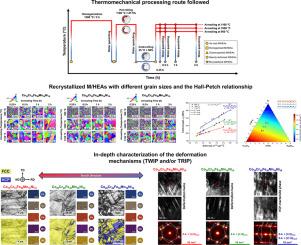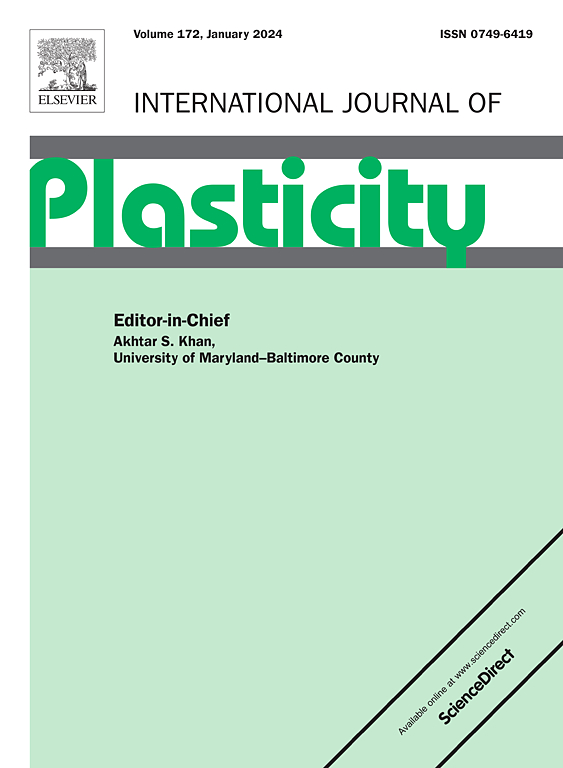Metastability-engineering strategy in CoCrFeMnNi-based medium- and high-entropy alloys: Unraveling the interplay with recrystallization, grain growth, and mechanical properties
IF 9.4
1区 材料科学
Q1 ENGINEERING, MECHANICAL
引用次数: 0
Abstract
Novel face-centered cubic (FCC) phase CoCrFeMnNi-based medium- and high-entropy alloys (M/HEAs) with the following nominal compositions Co15Cr15Fe50Mn10Ni10 (Co15Cr15), Co20Cr20Fe40Mn10Ni10 (Co20Cr20), and Co25Cr25Fe30Mn10Ni10 (Co25Cr25) in at.%, were designed via metastability-engineering strategy to trigger different deformation mechanisms, such as twinning-induced plasticity (TWIP) and/or transformation-induced plasticity (TRIP). Both mechanisms are governed by the stacking fault energy (SFE), which depends on composition. Fully recrystallized samples with different grain sizes ranging from 2.7 to 102.5 µm were obtained. Tensile tests were conducted at room temperature (298 K), and Hall-Petch relationships were established. The annealed and deformed samples were characterized by a combination of electron backscatter diffraction (EBSD), high-energy synchrotron X-ray diffraction (HE-SXRD), and transmission electron microscopy (TEM) to correlate deformation microstructures with phase stability. It was revealed that grain refinement was more effective in the Co25Cr25 alloy, given by the high Hall-Petch coefficients ( = 516 MPa.µm1/2 and = 198 MPa). For a grain size of 2.7 µm, the product of yield strength (∼500 MPa) and uniform elongation (∼45 %) in the Co25Cr25 alloy reaches its maximum (∼23 GPa%), achieving the optimal strength-ductility synergy. Due to the decrease in the effective SFE (from 26.6 to 3.5 mJ m-2), a transition in the dominant deformation behavior occurred from TWIP (Co15Cr15) to TWIP/TRIP (Co20Cr20) and finally to TRIP (Co25Cr25). The calculations further showed that and the total dislocation density exhibit an inverse relationship with the effective SFE. Such findings highlight the potential of compositional tuning for developing high-performance M/HEAs with designed deformation mechanisms.


cocrfemnni基中高熵合金的亚稳态工程策略:揭示再结晶、晶粒生长和力学性能之间的相互作用
通过转移性工程策略,设计了新型面心立方(FCC)相 CoCrFeMnNi 基中熵和高熵合金(M/HEAs),其标称成分为 Co15Cr15Fe50Mn10Ni10 (Co15Cr15)、Co20Cr20Fe40Mn10Ni10 (Co20Cr20) 和 Co25Cr25Fe30Mn10Ni10 (Co25Cr25),at.通过转移性工程策略设计了这两种材料,以触发不同的变形机制,如孪晶诱导塑性(TWIP)和/或转化诱导塑性(TRIP)。这两种机制都受堆叠断层能(SFE)的制约,而堆叠断层能取决于成分。我们获得了晶粒大小从 2.7 微米到 102.5 微米不等的完全再结晶样品。拉伸试验在室温(298 K)下进行,并建立了霍尔-佩奇关系。退火和变形样品通过电子反向散射衍射(EBSD)、高能同步辐射 X 射线衍射(HE-SXRD)和透射电子显微镜(TEM)进行表征,以将变形微结构与相稳定性联系起来。研究发现,Co25Cr25 合金的霍尔-佩奇系数较高(kHP = 516 MPa.µm1/2,σ0 = 198 MPa),因此晶粒细化更为有效。晶粒尺寸为 2.7 µm 时,Co25Cr25 合金的屈服强度(∼500 MPa)和均匀伸长率(∼45%)的乘积达到最大值(∼23 GPa%),实现了最佳的强度-电导率协同效应。由于有效 SFE 的降低(从 26.6 mJ m-2 降至 3.5 mJ m-2),主要变形行为从 TWIP(Co15Cr15)过渡到 TWIP/TRIP(Co20Cr20),最后过渡到 TRIP(Co25Cr25)。计算进一步表明,kHP 和总位错密度与有效 SFE 呈反比关系。这些发现凸显了成分调整在开发具有设计变形机制的高性能 M/HEAs 方面的潜力。
本文章由计算机程序翻译,如有差异,请以英文原文为准。
求助全文
约1分钟内获得全文
求助全文
来源期刊

International Journal of Plasticity
工程技术-材料科学:综合
CiteScore
15.30
自引率
26.50%
发文量
256
审稿时长
46 days
期刊介绍:
International Journal of Plasticity aims to present original research encompassing all facets of plastic deformation, damage, and fracture behavior in both isotropic and anisotropic solids. This includes exploring the thermodynamics of plasticity and fracture, continuum theory, and macroscopic as well as microscopic phenomena.
Topics of interest span the plastic behavior of single crystals and polycrystalline metals, ceramics, rocks, soils, composites, nanocrystalline and microelectronics materials, shape memory alloys, ferroelectric ceramics, thin films, and polymers. Additionally, the journal covers plasticity aspects of failure and fracture mechanics. Contributions involving significant experimental, numerical, or theoretical advancements that enhance the understanding of the plastic behavior of solids are particularly valued. Papers addressing the modeling of finite nonlinear elastic deformation, bearing similarities to the modeling of plastic deformation, are also welcomed.
 求助内容:
求助内容: 应助结果提醒方式:
应助结果提醒方式:


